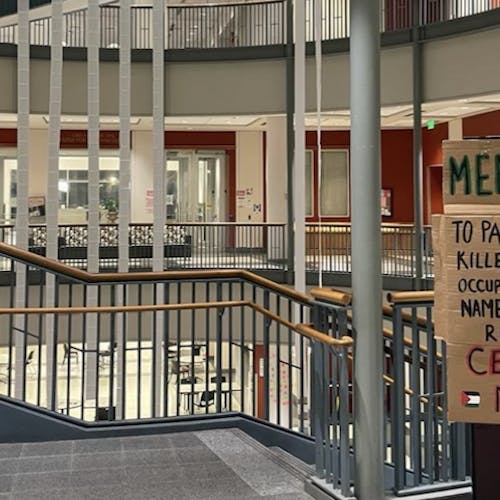Council talks city’s rezoning effects, concerns

As protestors and news crews crowded the stairs of the third floor of City Hall, their efforts did not interrupt the original meeting planned by the New Brunswick City Council.
With a majority of votes, the council passed an ordinance that permits a greater density of people to live in one unit of property, with one nay from council Vice President Rebecca Escobar.
The amendment addresses the rezoning proposal essentially allowing a landowner with limited land to build tall skyscrapers.
The rezoning would allow city property owners to arrange property into larger lots by allowing taller buildings to be built, said Glenn Patterson, director of the Department of Planning, Community and Economic Development.
“Five thousand square feet is the minimum [property size for a residential area] for New Brunswick, except in for certain zones on the other side of town [opposite of the hospital], “ he said.
With taller buildings, more people could live on one piece of property, Patterson said.
“It’s not going to change some of the existing properties but some may be affected,” he said.
Norma Hoffman, a homeowner on Hardenberg Street, said grants were given to the community to beautify the neighborhood, but this rezone would impede the efforts.
“They want to make our quiet, somewhat tree-lined neighborhood into a giant wall, and they want to start by buying a big parking deck on the first floor,” Hoffman said. “Our days of two- to three-story houses are giving way to 25-story apartments.”
Hoffman said the neighborhood was once considered peaceful but is no longer because of the construction.
“In terms of one giant building budding another 20-story building, where is the parking?” said Jadwiga Karanieviac, a homeowner on Condict Street. “What is the purpose of the Gateway Project?”
Karanieviac said the Gateway Project seemed to focus on the rich rather than the working class, and that the issue of parking has been apparent for years.
Patterson said about 20 percent of the rentals in the project are for affordable housing.
“We brought up the issue of college kids running in between parked cars and students in and out with multiple cars,” Karanieviac said. “I understand this is a college city but you want to put more apartments up and there is no parking.”
Karanieviac said the construction in the area surrounding her street caused living dilemmas in terms of noise and increased renovations.
“I lived in my house all my life. My family owned the house for more than 60 years and it’s changing,” she said. “Nobody told me that they are putting a business at the end of the street. This wasn’t here 60 years ago. It showed up within a matter of days.”
Karanieviac recently had to rearrange the bedrooms in her home because of noise complaints about college students.
“I understand Rutgers is right there, but I have the only family-owned house on the block and I just had to move the bedrooms to the back of the house to help with the noise,” she said. “Families still live on this block.”
But Patterson believes the amendment would be beneficial for the working-class population in New Brunswick as well.
“You’re in walking distance of the train station, the University and the hospital,” Patterson said.
Karanieviac argued saying the aesthetic appeal would be depreciated because of the uneven buildings.
“I don’t want to wake up one morning and have a brick wall on my patio,” she said. “I have a three-story home and you want to build 25 stories.”
Karanieviac said the ordinance was not right for the families living in the city.
“You know they already have a shovel ready and a building in its preliminary stage,” she said. “It’s disappointing.”
Correction: In and earlier version, the rezoning amendment was incorrectly described. It opposes a rezoning technique that allows owners of smaller lots to build buildings with lower heights and owners of bigger lots to construct buildings with taller heights. Also, this applies to all property owners, not just businesses. Finally, city Director of the Department of Planning, Community and Economic Development Glenn Patterson did not say a taller building with 100 square feet could hold 50 people but that the minimum plot size for this amendment is 50 by 100 square feet.



